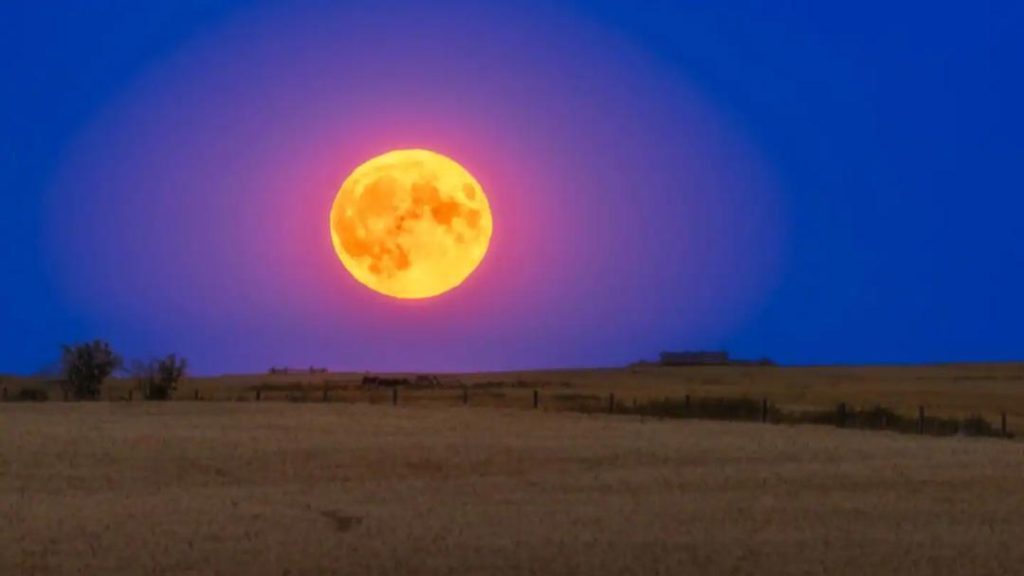
Buck Moon to Light up Skies on July 10 & 11
The Buck Moon, also known as July’s full moon, is all set to cast its magical spell on the night sky. According to astronomical predictions, the Buck Moon will peak at 3:08 am IST on July 11 in India and at 4:38 pm EDT on July 10 in the United States. This celestial event is a rare occurrence that has been observed and named by Native American tribes, such as the Algonquin, who marked the time when male deer, or bucks, begin growing new antlers.
The Buck Moon is the third full moon of the summer season in the Northern Hemisphere and is often associated with the lush green forests and fields of July. As the moon reaches its peak, it will be accompanied by other celestial bodies, including Mars, Venus, and Saturn, which will be visible in the night sky before and after the moon’s peak.
The Buck Moon gets its name from the Algonquin Native American tribe, who believed that the full moon in July marked the time when male deer, or bucks, began growing their new antlers. This marked the start of the mating season for deer, and the Algonquin referred to this full moon as the “Buck Moon.”
In contrast to the other full moons of the year, the Buck Moon is often associated with warmth and growth. As the summer season reaches its peak, the Buck Moon serves as a reminder of the abundance and fertility of the season. In many cultures, the Buck Moon is also associated with good hunting and gathering, as the full moon provides ample light for outdoor activities.
To catch a glimpse of the Buck Moon, sky gazers can look for the full moon on the night of July 10 and 11. The moon will be visible in the eastern part of the sky around sunset, and will continue to rise higher in the sky as the night progresses. As the moon reaches its peak, it will be accompanied by the planets Mars, Venus, and Saturn, which will be visible in the night sky.
Mars, the red planet, will be visible in the southeastern part of the sky, while Venus will be visible in the southwestern part of the sky. Saturn, the ringed planet, will be visible in the northeastern part of the sky. Sky gazers can use a pair of binoculars or a telescope to get a closer look at these celestial bodies.
The Buck Moon is also an important event for astronomers, as it marks the start of the peak summer season for stargazing. As the nights become warmer and longer, sky gazers can take advantage of the clearer skies to spot a variety of celestial bodies, including planets, stars, and constellations.
In addition to the Buck Moon, the summer season also brings a variety of other celestial events, including meteor showers and planetary alignments. The Perseid meteor shower, one of the most popular meteor showers of the year, will take place in mid-August, while the alignment of the planets will take place in late July.
For those who are interested in observing the Buck Moon, there are a few tips to keep in mind. The best time to view the full moon is usually around sunset, when the moon is low on the horizon. This is because the moon’s light is refracted through the Earth’s atmosphere, giving it a warm, golden glow.
Sky gazers can also use a pair of binoculars or a telescope to get a closer look at the Buck Moon and other celestial bodies. These tools can help to reveal more detail and provide a more intimate view of the night sky.
In conclusion, the Buck Moon is a rare and special event that is sure to captivate the hearts of sky gazers and astronomers alike. As the full moon reaches its peak, it will be accompanied by the planets Mars, Venus, and Saturn, providing a celestial show that is not to be missed. So, mark your calendars for July 10 and 11, and get ready to experience the magic of the Buck Moon.
Source:
https://www.newsbytesapp.com/news/science/buck-moon-2025-when-how-to-see-july-s-full-moon/story






